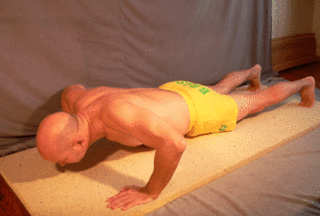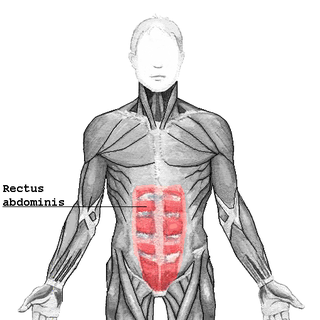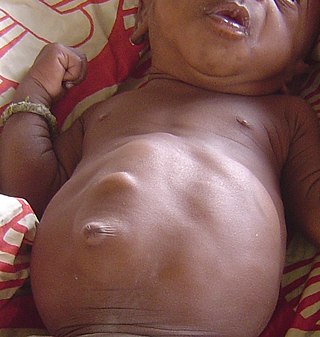
The human leg is the entire lower limb of the human body, including the foot, thigh or sometimes even the hip or buttock region. The major bones of the leg are the femur, tibia, and adjacent fibula. The thigh is between the hip and knee, while the calf (rear) and shin (front) are between the knee and foot.

The push-up is a common calisthenics exercise beginning from the prone position. By raising and lowering the body using the arms, push-ups exercise the pectoral muscles, triceps, and anterior deltoids, with ancillary benefits to the rest of the deltoids, serratus anterior, coracobrachialis and the midsection as a whole. Push-ups are a basic exercise used in civilian athletic training or physical education and commonly in military physical training. They are also a common form of punishment used in the military, school sport, and some martial arts disciplines. Variations of push-ups, such as wide-arm push-ups, diamond push-ups target specific muscle groups and provide further challenges.
Abdominal muscles cover the anterior and lateral abdominal region and meet at the anterior midline. These muscles of the anterolateral abdominal wall can be divided into four groups: the external obliques, the internal obliques, the transversus abdominis, and the rectus abdominis.

The rectus abdominis muscle, also known as the "abdominal muscle" or simply the "abs", is a pair of segmented skeletal muscle on the ventral aspect of a person's abdomen. The paired muscles are separated at the midline by a band of dense connective tissue called the linea alba, and the connective tissue defining each lateral margin of the rectus abdominus is the linea semilunaris. The muscle extends from the pubic symphysis, pubic crest and pubic tubercle inferiorly, to the xiphoid process and costal cartilages of the 5th–7th ribs superiorly.

An exercise ball is a ball constructed of soft elastic, typically in 5 diameters of 10 cm increments, from 35 to 85 cm, and filled with air. The air pressure is changed by removing a valve stem and either filling with air or letting the ball deflate. It is most often used in physical therapy, athletic training and exercise. It can also be used for weight training.

The transverse abdominal muscle (TVA), also known as the transverse abdominis, transversalis muscle and transversus abdominis muscle, is a muscle layer of the anterior and lateral abdominal wall, deep to the internal oblique muscle. It is thought by most fitness instructors to be a significant component of the core.

The abdomen is the part of the body between the thorax (chest) and pelvis, in humans and in other vertebrates. The abdomen is the front part of the abdominal segment of the torso. The area occupied by the abdomen is called the abdominal cavity. In arthropods it is the posterior tagma of the body; it follows the thorax or cephalothorax.
Abdominal exercises are a type of strength exercise that affect the abdominal muscles. Human abdominal consist of four muscles which are the rectus abdomens, internal oblique, external oblique, and transversus abdominis. When performing abdominal exercises it is important to understand the effects, functions, the types of exercises, and think about how to perform this exercise safely.
A bent-over row is a weight training exercise that targets a variety of back muscles. Which ones are targeted varies on form. The bent over row is often used for both bodybuilding and powerlifting.

The crest of the ilium is the superior border of the wing of ilium and the superiolateral margin of the greater pelvis.

Diastasis recti, or rectus abdominis diastasis, is defined as a gap of about 2.7 cm or greater between the two sides of the rectus abdominis muscle. The distance between the right and left rectus abdominis muscles is created by the stretching of the linea alba, a connective collagen sheath created by the aponeurosis insertions of the transverse abdominis, internal oblique, and external oblique. This condition has no associated morbidity or mortality. Physical therapy is often required to repair this separation and surgery is an option for more severe cases. Standard exercise rarely results in complete healing of the separated muscles.
Active sitting is the practice of enabling or encouraging individuals to engage in physical activity while seated. It is also commonly known as dynamic sitting. The underlying notion highlights the advantages of incorporating flexibility and movement while sitting, as it can positively impact the human body and allow the completion of certain tasks that require sitting. "Active sitting, consisting of modified chairs or stability balls, allows the body to stay dynamic while seated." One of the earliest forms of active sitting is the common rocking chair which allows forward and backward swaying motion.

Standing, also referred to as orthostasis, is a position in which the body is held in an erect ("orthostatic") position and supported only by the feet. Although seemingly static, the body rocks slightly back and forth from the ankle in the sagittal plane. The sagittal plane bisects the body into right and left sides. The sway of quiet standing is often likened to the motion of an inverted pendulum.

The Roman chair is a piece of exercise equipment. It is mainly used for the lower back, but can also target the buttocks, hamstrings, and abdomen. The definition of the equipment, and what 'Roman chair exercise' specifically means, is not clear.
In kinesiology, core stability is a person's ability to stabilize their core. Stability, in this context, should be considered as an ability to control the position and movement of the core. Thus, if a person has greater core stability, they have a greater level of control over the position and movement of this area of their body. The body's core is frequently involved in aiding other movements of the body, such as running; thus it is known that improving core stability also improves a person's ability to perform these other movements.

The leg raise is a strength training exercise which targets the iliopsoas. Because the abdominal muscles are used isometrically to stabilize the body during the motion, leg raises are also often used to strengthen the rectus abdominis muscle and the internal and external oblique muscles.

The hip bone is a large flat bone, constricted in the center and expanded above and below. In some vertebrates it is composed of three parts: the ilium, ischium, and the pubis.

The pelvis is the lower part of the trunk, between the abdomen and the thighs, together with its embedded skeleton.

A kick is a skill in association football in which a player strikes the ball with their foot. Association football, more commonly referred to as football and also known as soccer, is a sport played world-wide, with up to 265 million people around the world participating on a yearly basis. Kicking is one of the most difficult skills to acquire in football. This skill is also vitally important, as kicking is the way in which passes are made and the primary means by which goals are scored.

Core Strength Vinyasa Yoga is a style of yoga as exercise created by American yogini Sadie Nardini in 2006. Central to this style is a movement referred to as a 'wave' (softening). The structure of this practice includes a 7-step framework which is applied to each pose within a sequence. Nardini incorporates aspects of Kundalini Yoga, Sivananda Yoga, Anusara Yoga, Iyengar Yoga, and portions of movement sequences from Ashtanga Vinyasa Yoga. Maintaining an internal focus on joy in the moment is part of the practice philosophy. This style integrates postures with learnings from many disciplines including physics, biology, and geometry, influenced by the works of Leslie Kaminoff. It incorporates traditional yoga philosophy from the Yoga Sutras of Patanjali. It emphasizes muscles that are deep within the body and includes the use of 'waves' in order to enter and exit poses. Examples include physical moves that activate muscles close to the spine—such as psoas and quadratus lumborum in order to build support for the body from within before generating outward expression of that movement. The purpose of deep core focused poses in this practice is to improve and deepen breathing. This perspective differs from other styles in which the purpose of deep core work is to stabilize the back. In this practice, keeping belly soft and core strong improve breathing. "Belly Bonfire" breath is one example of a deep core breath technique that involves focus and target of attention and breath with softer abs. Pelvis is viewed as the body's physical center of gravity in this system.

















